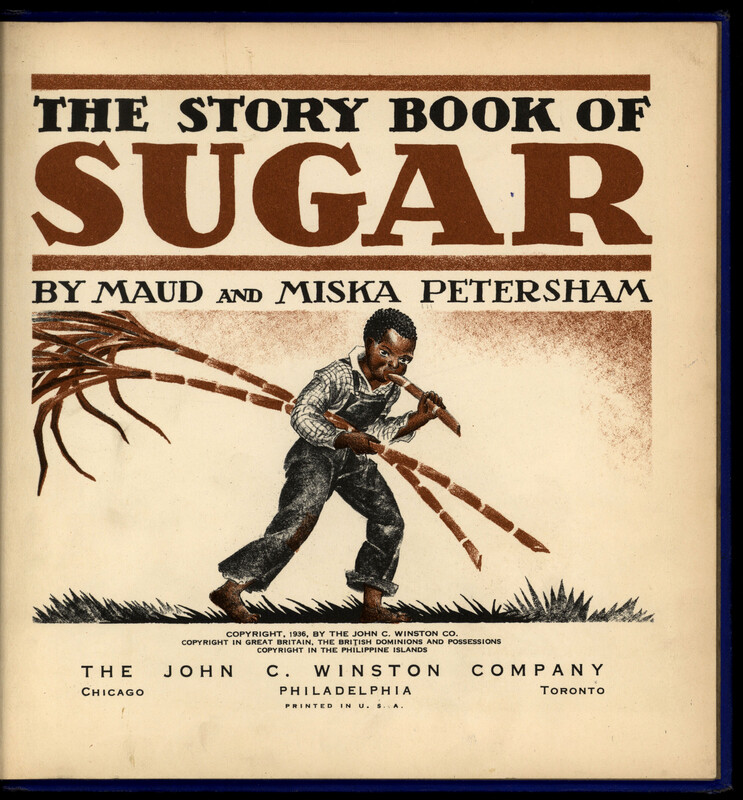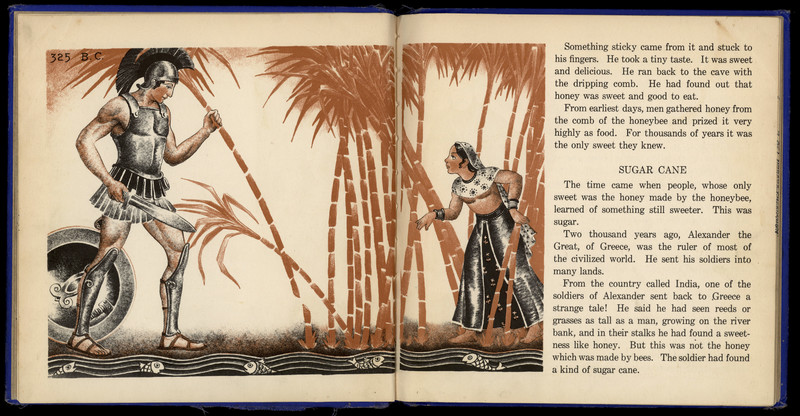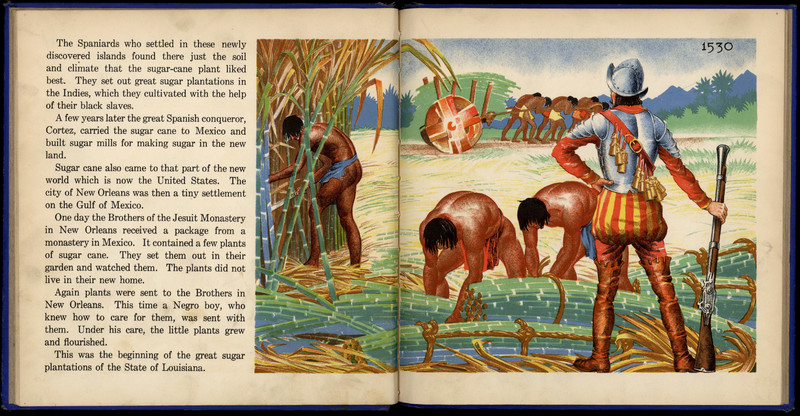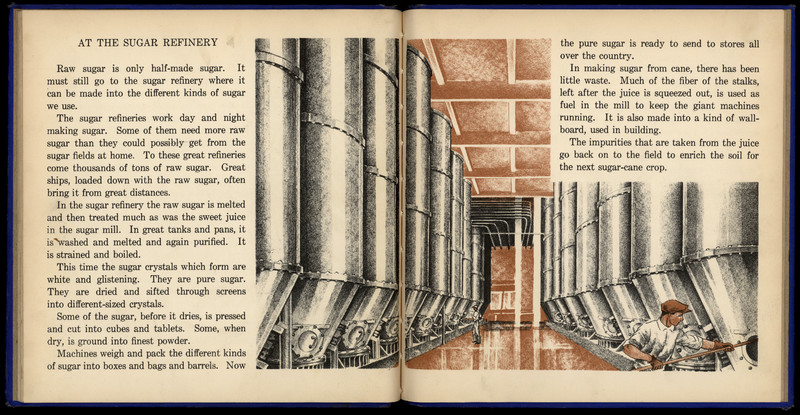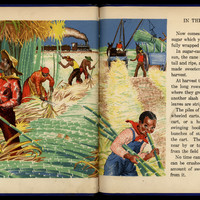The Story Book of Sugar
Item- Title
- The Story Book of Sugar
- Description
-
During the interwar period, author-illustrator team Maud and Miska Petersham created some of the most memorable fiction stories and textbooks for children. With publishers’ renewed interest in children’s books about everyday life, the production story genre was revived in the US with a series by Janet Smalley, closely followed by the Petersham’s comprehensive series comprised of five textbooks: The Story Book of The Things We Use (1933), about houses, food, and transportation; The Story Book of Earth’s Treasures (1935), about gold, coal, oil, iron, and steel; The Story Book of Wheels, Ships, Trains, Aircraft (1935); The Story Book of Foods from the Field (1936), about wheat, corn, rice, sugar; and The Story Book of Things We Wear (1939), about wool, cotton, silk, and rayon. Each of these five contain sections on different commodities that could be purchased as separate volumes. Most of the contents from The Storybook of Sugar (1936) also appear in the volume Foods from the Field (Bader, 93-97). This way of organizing a series by related commodities follows the same marketing strategy used by John Wallis, over a hundred years earlier.
The title page for The Story Book of Sugar features a black child chewing cane. Another child chewing cane appears on the dust jacket for The Story Book of Foods from the Field. And a similar boy appears in the corner of an image depicting the cane harvest, titled “In the Sugar-Cane Field.” This cane harvester, chewing cut cane, has a long history. The figure appears in sugar production stories over the past two hundred years, changing to represent the labor force primarily responsible for sugar production, from enslaved Africans to free workers of different races and ethnicities. What is this figure’s perennial appeal? One possibility is that the harvester chewing cane encourages readers’ empathy without challenging their privilege: The image reassures privileged consumers who purchase and eat sugar far away from where cane is grown that children involved in the sugar labor force have plenty of food—indeed, they enjoy treats, just like children everywhere. While encouraging readers to sympathize with producers, such images also spread a cheerful veneer over questionable labor practices.
In earlier production stories, the cane chewing figure originated with proslavery literature, which depicted slaves eating cane during harvest to contradict accounts of starvation in cane fields. However, the Petershams partially transform the image by making the cane chewer a child who meets the reader’s gaze. They also feature children eating grains in each segment of The Foods of the Field, where they eat bread, rice, and corn. This suggests that the Petershams are combining two visual tropes: the cane chewing harvester with the child consumer (who generally appears on the final spread of production stories, see for e.g. Hollos’s books).
The Storybook of Sugar covers different sweeteners: honey, cane sugar, beet sugar, and maple syrup. Despite this global perspective on sweets, The Story Book of Sugar credits European ingenuity for sugar’s development by focalizing the story through white characters. For instance, the text acknowledges that mass cultivation of sugarcane began in India, yet readers learn about this fact from the perspective of Alexander’s soldier. The tall, armored man dominates the page, as a strong but relatively friendly figure, who “discovers” sugar during an invasion of regions that are now parts of Pakistan and India. Likewise, the section on Spanish sugar cane credits a “negro boy” sent to “the Brothers of the Jesuit Monastery in New Orleans” with figuring out how to cultivate cane, but the text glosses over the child’s enslavement by grouping him with the plants: “Again plants were sent to the Brothers in New Orleans. This time a Negro boy, who knew how to care for them, was sent with them.” The accompanying illustration positions the Spanish overseer in the foreground, his back to readers, which invites viewers to survey the sugar cane plantation from his perspective. The image includes enslaved persons, their bodies bent in labor, but signs of violence and coercion are downplayed.
The modern refinery in the final spread captures another visual convention of production stories: the love of modern technology. Factory scenes usually make machinery the star, using repetition to create aesthetic appeal. Wondrous machines draw the viewer’s eye. We admire their size and strength, while human operators seem small and unimportant. In production stories, workers may appear as disembodied hands, or as nearly unrecognizable figures on a massive factory floor. (For a contrasting approach, see the recognizable faces in The Story of Your Coat.)
In historical surveys of sugar production, machines capture the imagination after the abolition of slavery in the United States, and texts may even praise machines as “slaves,” as if modern factories ended slavery. However, technological progress does not necessarily coincide with social progress. Sugar production during the time of American slavery also relied on advanced manufacturing technologies and chemical processes. The enslaved persons who worked in mills, refineries, or other manufacturies had to learn specialized engineering knowledge, even though they were not paid or recognized for their skills. Additionally, modern workers may continue to face discrimination or poor working conditions, regardless of whether they use modern machinery.
- Creator
- Petersham, Maud Fuller
- Petersham, Miska
- Contributor
- Petersham, Maud Fuller (illustrators)
- Petersham, Miska
- Date
- 1936
- Subject
- production story
- sugar
- Rights
- Text and image copyright 1936 by Maud Fuller and Miska Petersham. Text and images used under fair use.
- Obtained permission for digital images.
- The Rare Book & Manuscript Library, University of Illinois at Urbana-Champaign.
- Identifier
- Rare Book & Manuscript Library, University of Illinois at Urbana-Champaign, Call Number/Collection ID: S.633 P44S
- Bibliographic Citation
- Petersham, Maud Fuller and Petersham, Miska. (1936). The Story Book of Sugar. Philadelphia: John C. Winston Company.
- Site pages
- Chewing Cane
